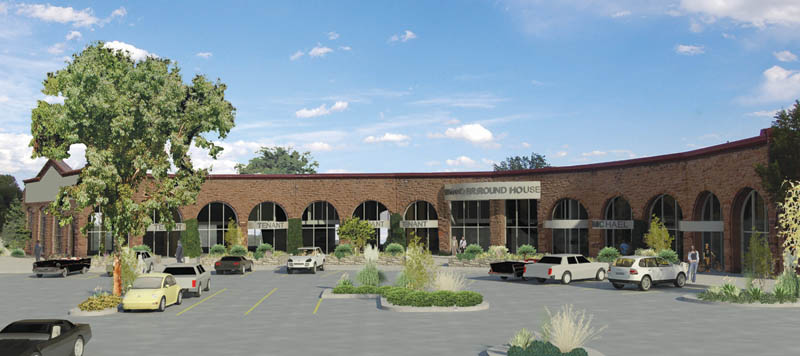
Steve Engel, president of the Griffis/Blessing development company, said work on the center - to be called “The Roundhouse” - could start as early as Dec. 1, with the hope of having space ready for tenants by spring.
Van Briggle Pottery, which has owned the building since the 1950s and had full operations there since about 1970, will relocate to an as-yet-undetermined location. Craig Stevenson, part of the family ownership, said a search has been under way (a smaller site is being sought, until the economy improves), and announcement of a new locale will probably be made in November. The family will retain ownership of the roundhouse property for the time being.
The basic property redevelopment plans have not changed since Griffis/ Blessing submitted an application to the city last February. Phase 1 will feature upgrades to the roundhouse building (22,645 square feet on the main level, about 10,000 on the second floor).
Phases 2 and 3, each involving the construction of a smaller freestanding building, will be built “when we have tenants,” Engel said.
Most of the roundhouse work will be on the inside - installing modern utilities and remodeling to suit future tenants. The exterior will look much the same, but get a “complete facelift,” Engel said. Perhaps the most dramatic touches will be to the arched openings which, during the 62-year Midland railroad era, had doorways that opened or closed for locomotives needing storage or repair. The archways will be glassed in (currently, they are open, with a framed structure behind them), and this will make the main level more bright and airy, he described.
“It's such a beautiful building as it is,” Engel said. “It won't look much different than it is today We're just trying to enhance what's there.”
Retail is expected to be the main use in the building. No businesses have been announced as yet.
In addition to the existing building's upgrades, initial work will consist of curb, gutter and sidewalks and the construction of three access points to the center (a right- in/right-out at 21st Street, a right-in from Bott just west of 21st and a full-access farther west on Bott. Also going in during Phase 1 will be parking lot improvements, signage and landscaping, Engel said.
The Ramblin' Express bus, which picks up Cripple Creek gambling riders in the Van Briggle parking lot, will have to seek a new location. This should occur sometime before Dec. 1, he said.
The issues with the city chiefly concerned traffic. Based on distance from the highway, city traffic engineers initially opposed any access from 21st Street (there is currently full access); also, long-range city plans had called for the elimination of the stoplight at 21st and Bott (which would have forced vehicles on Bott to turn right only).
The city relented on both (the state as well on the 21st Street access). That concern was largely based on how fast eastbound highway vehicles come around the corner at 21st Street to go south on 21st. So a bump-out is to be built at the corner to make the turn sharper and “help slow people down,” City Planner James Mayerl explained. Also, the Van Briggle ownership agreed to give up property along 21st Street to allow a separate “deceleration lane” for people turning into the center.
Keeping the Bott signal is not in writing, but Mayerl said “there are no plans to change the stoplight in the future.” Engel added his belief that, based on discussions with the city, “I'm convinced the light will stay.” In fact, one of his costs on the project is relocating a stoplight pole because of the change to the property's corner at 21st Street and Bott Avenue, he pointed out.
One of the reasons for eliminating the Bott light was to accommodate Gold Hill Mesa's future commercial area east of 21st Street, which would be accessed from Broadway Street. However, Engel sees no reason why there can't be stoplights at both Bott and Broadway.
Another issue was the location of the rectangular, 7,520-square-foot Phase 3 building at the northwest corner of the roundhouse property. Its original position was north-south, but the owners of neighboring Ghost Town complained that this would block the view of their attraction from the 21st and Highway 24 intersection. So Griffis/Blessing agreed to turn the building 90 degrees, improving the sightline.
The Phase 2 building is approved at 3,560 square feet, near the corner of Bott and 21st streets.
Engel believes the Roundhouse will be popular because of its location. “The intersection of 21st and Highway 24 is the crossroads of the Westside, and this is the crown jewel of the crossroads,” he said. “It will be an attractive location for business for years to come.”
Westside Pioneer article